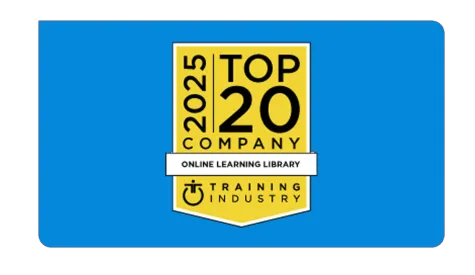The Complex Levels of Content Curation and Vetting

In training and development, content is important. But finding (or creating) quality content is only the first step in the process of building a training library. Content curation (including content vetting) is just as crucial—and worth investing in.
Although many people talk about curation, few have come out and explicitly outlined what content curation is in a training context. Really, content curation is not all that different from, say, museum curation. A museum can gather a number of artifacts, but until the museum curator does his or her job, the museum simply has a collection. Once the curator gathers the items, sets them on display along a path that others will follow, and helps explain the items and their significance, what was previously a collection has now become a curated exhibit.
Something similar happens with content. The content itself is important, of course, but merely gathering the content together is insufficient for training. It gives you, at most, a content collection. To be maximally effective, content must be curated. This includes:
- Sorting and vetting the content to choose what is appropriate
- Figuring out how to store the content
- Figuring out how (and when) learners will access the content
- Putting the content in logical order and creating courses of study
- Providing context and commentary
- Empowering learners to also leave commentary
- Customizing content and courses for specific needs
Without curation, courses quickly become abandoned, content grows stale, and training becomes a mish-mash of tips and advice without any coherent organization.
Seeing the importance of curation, we can talk about various levels of curation that exist in some content collections. Spoiler alert: It turns out that a maximal level of curation is best, and these are usually provided by modern Learning Management Systems.
Level 1: No Content Curation
There are some situations where no curation occurs. This is usually the case when an organization has a “library” of physical content items: Books, DVDs, pamphlets, or (gasp) VHS tapes. In many cases, a well-intentioned person takes on the curation of this library to start, but, as time passes, that person leaves, gets busy, or simply becomes disinterested.
With no curation, learners might be able to access the content, but there is no organization and no sense of what content is needed for which people, nor when. If content is added to the library, it might be vetted, or it might not...there’s no way to tell.
This isn’t to say that such a library is a bad thing. Having a content collection is better than no content at all. There is also something about owning physical copies of a book or DVD; some employees simply like to be handed their content to hold and carry. This is especially true of more seasoned employees, or those uncomfortable with using the internet.
Still, for this benefit to outweigh the costs, there needs to be an internal champion willing to organize the library, taking it to...
Level 2: Light Curation
Light curation includes some of the elements of a curated content collection, but not all or most. This often happens when content is merely “collected” from the internet.
Take, for example, a company that is interested in training videos but wants to get by as cheaply as possible. The sales manager finds a bunch of videos on sales tips on YouTube and sends the links around to the sales team. In this case, the sales manager has made a decision to use video and gives the team access to those videos. The team can watch them when convenient, and can even leave comments on YouTube’s platform (along with everyone else in the world).
The downside, of course, is that this content has not been vetted. Virtually anyone can post content, meaning that bias and conflicts of interest can sneak in. Furthermore, that content is the property of YouTube: There is no sense in which the sales manager owns the content. This means that YouTube (and the content’s poster) can change or remove the content without warning.
Perhaps most important, however, is that the content is not organized in any meaningful way—unless the manager takes the time to do it, that is. Once someone takes the time to vet the content, organize it, distribute it, and follow up, any savings might well be outweighed by costs in terms of time spent.
Level 3: Moderate or “Healthy” Curation
For most organizations, light curation will not be enough to create a course of training or support development in any serious way. Most of the above elements have to be in place to have a healthy level of content curation that will actually bring value to the organization.
This level of curation is usually reached with a library of content purchased from a reputable eLearning organization. This content has been crafted by experts, pre-vetted, and many times organized into appropriate subject areas and courses. While such libraries tend to be “one-size-fits-all” and lack the ability to customize, they are still highly accessible and can, with some elbow grease, be organized into a training sequence.
Some organizations get around the customization issue by creating some or all of their content in-house. This gives the maximum level of control over the content, and maximum flexibility in tailoring it to fit specific needs. It is very resource intensive, however. For that reason, more and more companies are moving to a hybrid model: Buying off-the-shelf content for most of their basic training programs, and keeping the option of in-house videos for special needs or projects. Indeed, here at HSI we often work with clients who have already purchased our off-the-shelf content but who want to add some custom content (in the form of a company intro, field example, or sometimes an entire video or course).
Level 4: Full-Blown Learning Management
At a certain point, enough content curation is occurring on a regular basis that the organization is doing more than “mere” curation: They are fully managing a program of development for their employees and guiding them through it. This level is almost always achieved by using a quality Learning Management System (LMS) that allows organizations to organize content and track completion. A good LMS will also allow organizations to provide trainer context, learner comments, tools for accountability, and useful reports.
An LMS can easily augment an existing digital library or an in-house custom library (or hybrid model). A simple way to think of it is that the library provides the content, while the LMS provides or enables the actual curation. Level 4 curation can be done without an LMS, of course—but it becomes very labor-intensive and prone to error. The more employees an organization needs to train, the more these become issues.
Putting it Together
There may well be other kinds of content libraries besides the ones discussed above. What we’ve discussed here, however, is a framework for looking at their curation. Given a content library and how it is handled, you should be able to place it at a specific level. This will help you to understand whether a given library will suit your development needs.
So, as an exercise, let’s look back at some of the above examples and the level of curation that can be had for any training programs using them:
Additional Resources
- If you are looking for eLearning training content, our blog post will be very helpful: "How to Buy eLearning Content for Your LMS (And Not Regret It Later)"
- Our white paper "7 Ways Off-the-shelf Content Brings Value" as you consider adding to your training library.
- Similarly, this white paper "How Many eLearning Courses Do You Really Need?" can help you answer the question as you start comparing vendors who tout thousands and thousands of courses.
- If you have a small training department, our blog post "Are You a Training Department of One?" will be a good resource as well.


